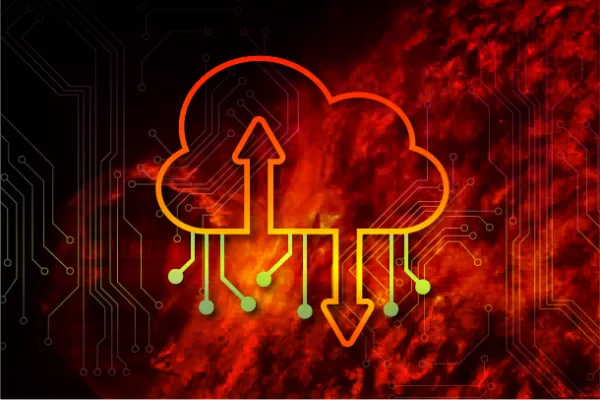So, who saw, let’s face it, the stunning Aurora Borealis that graced most of the Northern hemisphere earlier this month? I missed it, but still spent most of the next night peering into the night sky, hopeful. – Bucket list item still not checked.
The images of the event that flooded the internet the next day, were indeed something to behold… they were beautiful… But, just how dangerous to our beloved digital data could an event like this be. Could a solar storm destroy your data or damage your devices?
What is a Solar Storm?
The Sun has periods of high activity called solar maximums! They are cyclical, occurring every 11 years or so. During this period, the sun can throw out massive amounts of energy in the form of solar flares and coronal mass ejections that can send a stream of electrical charges and magnetic fields towards earth. These come in varying classed strengths as in: A, B, C, M & X-class flares, the latter being the daddy of them all.
A number of powerful X-flares is what caused the recent Northern lights that appeared across the globe and also caused a fair few radio outages for some. These recent flares did not create a coronal mass ejection of magnetic energy however, that would have adversely affected our hardware or data. Phew
What if a Coronal Mass ejection does hit the earth?
Could it happen? Of course it could! But, it is a rare event. In fact, it has already happened! in September 1859 a geomagnetic storm (known now as the Carrington Event https://en.wikipedia.org/wiki/Carrington_Event ) caused a multitude of telegraph stations to catch fire due to sparking. A storm of that magnitude in the present day, hitting the earth squarely could indeed cause a great deal of damage with widespread electrical disruptions, blackouts, data loss on unprotected devices and extended downtime to our much-loved online world.
Is it possible to protect your data & devices from solar storms?
Yes, it is possible to place safeguards to protect your data and devices!
Now, even we will admit that a few of these are, indeed a faff! But to cover the bases, we are going to mention them anyway – Hardcore preppers we aren’t.
Know what the sun is doing!
There are a few places on the internet that can send you notifications on the sun’s activity. If something is about to happen and the potential for dangerous activity is high, you can arrange to be notified. The heads-up approach. Look at SpaceWeatherLive.com for more information. https://www.spaceweatherlive.com/en/aurora-alerts.html
Unplug from the power grid!
To reduce the possibility of an EMP causing a power spike. Unplug your electronics or use a surge protector with anything connected to the mains power supply. Surge protecting is something you should be doing to protect your devices anyway for many reasons outside of the risk of solar storms – The modern-day power network is good, but things do happen.
Use a Faraday cage!
Now, I’d say this one is for the hardcore out there. As mentioned before, sounds like a faff trying to do this day to day. However, if you’ve signed up for solar flare notification, you’ll know whats coming, then having a faraday cage may well be a solution for those that want to tick all the boxes. The cage directs the incoming electrical charges around the objects within it, therefore protecting them. You can find out more about Faraday cages here.
Backup your Data and have a Plan! – The Qdos Digital Choice
Without question, having your data stored elsewhere is the best way to go! Cloud data storage centres are in the business of keeping your data safe and secure. They’ve placed levels of protection in their systems that go well beyond what a home or business user could even consider, let alone afford. Moving to a cloud computing & storage solution would be number 1 on the Qdos Digital IT Support Team’s to do list, to protect your digital assets. You can read more about Data Backup & Disaster Recovery at: https://qdos.digital/data-backup-disaster-recovery
If you’re a business - data is one of the most important assets you hold. Ensuring that data is protected is critical. Having a Data Backup & Disaster Recovery plan is certainly a good way to go, for many reasons – solar flares aside! Hardware failure, cyber-attacks, even human error could have your data disappear forever, plus these are more likely than a celestial event – Think of it as an insurance policy you may never need but are grateful you have… just in case.
Read more about what to do when Disaster Strikes here: https://qdos.digital/blog/it-support-sos-what-do-when-disaster-strikes
If the worst happens and the sun does decide to throw another Carrington Event at the Earth, you can be rest assured that your precious data will be safe & secure (within reason of course).
In Conclusion
Although the risk of a solar storm and EMP’s destroying your data and devices is a slim one – The risk to your data particularly from other potential disasters – isn’t. Making a plan of action and securing your digital assets should be a serious consideration, especially for business owners.
For more information on IT Support go to: https://qdos.digital/networks-it-support
Not sure where to go from here – Contact Qdos Digital and get your business data protected
Qdos Digital Solutions can be your IT department - We have it covered.







